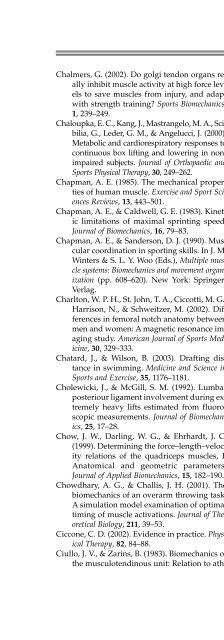Fundamentals of Biomechanics
Fundamentals of Biomechanics
Fundamentals of Biomechanics
You also want an ePaper? Increase the reach of your titles
YUMPU automatically turns print PDFs into web optimized ePapers that Google loves.
Chalmers, G. (2002). Do golgi tendon organs really<br />
inhibit muscle activity at high force levels<br />
to save muscles from injury, and adapt<br />
with strength training? Sports <strong>Biomechanics</strong>,<br />
1, 239–249.<br />
Chaloupka, E. C., Kang, J., Mastrangelo, M. A., Scibilia,<br />
G., Leder, G. M., & Angelucci, J. (2000).<br />
Metabolic and cardiorespiratory responses to<br />
continuous box lifting and lowering in nonimpaired<br />
subjects. Journal <strong>of</strong> Orthopaedic and<br />
Sports Physical Therapy, 30, 249–262.<br />
Chapman, A. E. (1985). The mechanical properties<br />
<strong>of</strong> human muscle. Exercise and Sport Sciences<br />
Reviews, 13, 443–501.<br />
Chapman, A. E., & Caldwell, G. E. (1983). Kinetic<br />
limitations <strong>of</strong> maximal sprinting speed.<br />
Journal <strong>of</strong> <strong>Biomechanics</strong>, 16, 79–83.<br />
Chapman, A. E., & Sanderson, D. J. (1990). Muscular<br />
coordination in sporting skills. In J. M.<br />
Winters & S. L. Y. Woo (Eds.), Multiple muscle<br />
systems: <strong>Biomechanics</strong> and movement organization<br />
(pp. 608–620). New York: Springer-<br />
Verlag.<br />
Charlton, W. P. H., St. John, T. A., Ciccotti, M. G.,<br />
Harrison, N., & Schweitzer, M. (2002). Differences<br />
in femoral notch anatomy between<br />
men and women: A magnetic resonance imaging<br />
study. American Journal <strong>of</strong> Sports Medicine,<br />
30, 329–333.<br />
Chatard, J., & Wilson, B. (2003). Drafting distance<br />
in swimming. Medicine and Science in<br />
Sports and Exercise, 35, 1176–1181.<br />
Cholewicki, J., & McGill, S. M. (1992). Lumbar<br />
posteriour ligament involvement during extremely<br />
heavy lifts estimated from fluoroscopic<br />
measurements. Journal <strong>of</strong> <strong>Biomechanics</strong>,<br />
25, 17–28.<br />
Chow, J. W., Darling, W. G., & Ehrhardt, J. C.<br />
(1999). Determining the force–length–velocity<br />
relations <strong>of</strong> the quadriceps muscles, I:<br />
Anatomical and geometric parameters.<br />
Journal <strong>of</strong> Applied <strong>Biomechanics</strong>, 15, 182–190.<br />
Chowdhary, A. G., & Challis, J. H. (2001). The<br />
biomechanics <strong>of</strong> an overarm throwing task:<br />
A simulation model examination <strong>of</strong> optimal<br />
timing <strong>of</strong> muscle activations. Journal <strong>of</strong> Theoretical<br />
Biology, 211, 39–53.<br />
Ciccone, C. D. (2002). Evidence in practice. Physical<br />
Therapy, 82, 84–88.<br />
Ciullo, J. V., & Zarins, B. (1983). <strong>Biomechanics</strong> <strong>of</strong><br />
the musculotendinous unit: Relation to ath-<br />
REFERENCES 261<br />
letic performance and injury. Clinics in<br />
Sports Medicine, 2, 71–86.<br />
Corbin, C. B., & Eckert, H. M. (Eds.) (1990). Resolution:<br />
The Evolving undergraduate major.<br />
AAPE Academy Papers No. 23 (p. 104).<br />
Champaign, IL: Human Kinetics.<br />
Corcos, D. M., Jaric, S., Agarwal, G. C., & Gottlieb,<br />
G. L. (1993). Principles for learning<br />
single-joint movements, I: Enhanced performance<br />
by practice. Experimental Brain Research,<br />
94, 499–513.<br />
Cornbleet, S. & Woolsey, N. (1996). Assessment<br />
<strong>of</strong> hamstring muscle length in school-aged<br />
children using the sit-and-reach test and the<br />
inclinometer measure <strong>of</strong> hip joint angle.<br />
Physical Therapy, 76, 850–855.<br />
Counsilman, J. E. (1971). The application <strong>of</strong><br />
Bernoulli's Principle to human propulsion<br />
in water. In L. Lewillie and J. Clarys (Eds.),<br />
First international symposium on biomechanics<br />
<strong>of</strong> swimming (pp.59–71). Brussels: Université<br />
Libre de Bruxelles.<br />
Cox, V. M., Williams, P. E., Wright, H., James,<br />
R. S., Gillott, K. L., Young, I. S., & Goldspink,<br />
D. F. (2000). Growth induced by incremental<br />
static stretch in adult rabbit latissimus<br />
dorsi muscle. Experimental Physiology,<br />
85(3), 193–202.<br />
Cronin, J., McNair, P. J., & Marshall, R. N.<br />
(2001a). Developing explosive power: A<br />
comparison <strong>of</strong> technique and training. Journal<br />
<strong>of</strong> Science and Medicine in Sport, 4, 59–70.<br />
Cronin, J. B., McNair, P. J., & Marshall, R. N.<br />
(2001b). Magnitude and decay <strong>of</strong> stretch-induced<br />
enhancement <strong>of</strong> power output. European<br />
Journal <strong>of</strong> Applied Physiology, 84,<br />
575–581.<br />
Cross, R. (2000). The coefficient <strong>of</strong> restitution for<br />
collisions <strong>of</strong> happy balls, unhappy balls,<br />
and tennis balls. American Journal <strong>of</strong> Physics,<br />
68, 1025–1031.<br />
Cross, R. (2002). Measurements <strong>of</strong> the horizontal<br />
coefficient <strong>of</strong> restitution for a super ball and<br />
a tennis ball. American Journal <strong>of</strong> Physics, 70,<br />
482–489.<br />
Daish, C. B. (1972). The physics <strong>of</strong> ball games. London:<br />
The English Universities Press.<br />
Darling, W. G., & Cooke, J. D. (1987). Linked<br />
muscle activation model for movement generation<br />
and control. Journal <strong>of</strong> Motor Behavior,<br />
19, 333–354.






